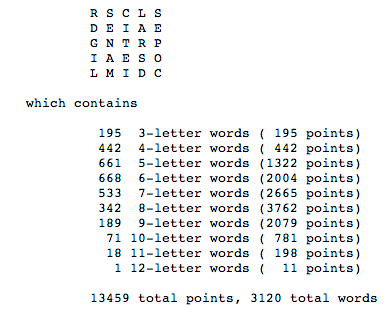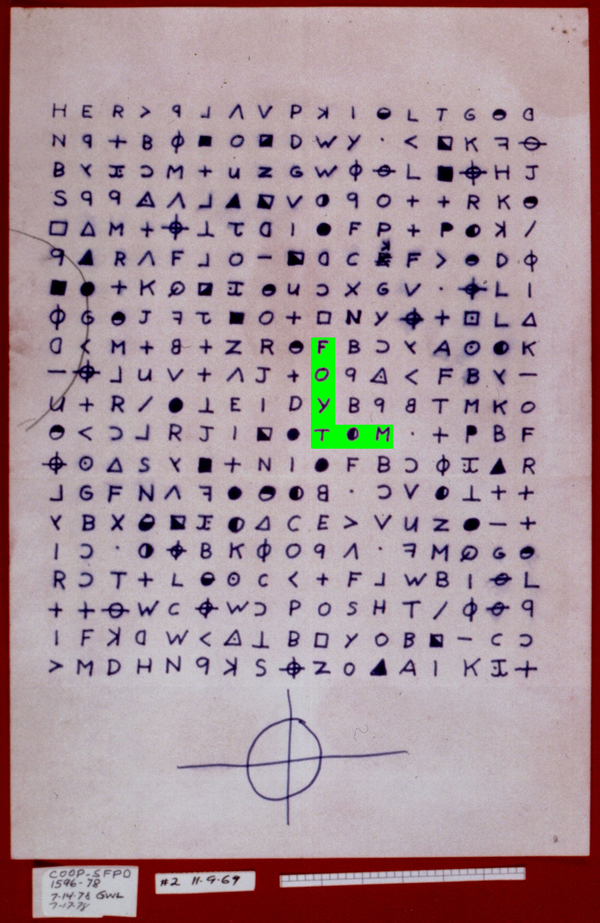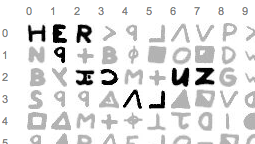Nice. ![]()
The possibilities are endless.
More examples:
- Take a leg off "R", splitting the letter into "P" and "I"
- Split "B" into "I" and "m" (or "w" or "e")
- Split "X" into "I" and "T"
- Convert letters phonetically into syllables. Example: "F" = "EFF", which can match EFFECT, JEFF, EFFORT, etc.
- Toss numbers into the mix. Example: B = 8, or 13. Z = 2. Etc.
[/list:u:1se1dmj2]
This work resembles some previous studies of "dense Boggle boards":
http://ai.stanford.edu/~chuongdo/boggle/
For example, a dense 5×5 board with a high concentration of words is:

Homework assignment: Create a 5×5 Boggle board that has a dense concentration of Zodiac-specific words. ![]()
Blast. When I get home I’m going to feel compelled to do this! ![]()
Great job on this really well executed exercise! It must have been quite a lot of fun and effort to code this. I am glad that my little sand castles inspired you to debunk the idea of finding apparent strings using such flexible rules ![]()
Unfortunately, I must concede after seeing your post that the strings (peek-a-boo, you doomed) I originally found are most likely coincidental. The only small doubt that persists in my mind relates to the semi-circular and connected shape of these strings which is very similar to how they are written in the HC.
Ah well. Back to the sandbox…
Here’s an online gadget that lets you search for words yourself:
http://www.zodiackillerciphers.com/?p=420
Kind of pointless, but it was fun to make.
Here’s an online gadget that lets you search for words yourself:
http://www.zodiackillerciphers.com/?p=420
Kind of pointless, but it was fun to make.
Fun to use too. Thanks. ![]()
Very amusing tool! From my original posts on this subject, I had found it peculiar that you could read "cipher" at the very top-left of the z340. I played with this and found an interesting variation:
Or:
Here’s a short description about null ciphers (found via google at michael555x.wordpress.com):
Null ciphers provide a way of concealing a message within a larger body of plain text without the need for a complicated cryptosystem, and they can also be effective depending on the size of the message compared to the amount of plaint text, and also how it’s implemented. Again, this can have advantages over cryptography. […] Usually, the secret text is encoded as every nth character of a plain text, but there’s a high risk of discovery. To reduce the chances of that happening, another method should be used to determine the placement of the secret characters, ideally a method that gives the appearance of randomness, such as the Fibonacci and prime number sequences.
The prime number part (the emphasis is from me) reminded me of this post by Doranchak : http://www.zodiackillerciphers.com/?p=319 where he highlights the fact that only 1 "+" and 1 "B" symbol (the 2 most frequent symbols) are placed in a prime position.
From that post:
Why would the cipher symbols be biased against prime positions? Is there something to this, or are we just chasing noise again?
If the z340 was a null cipher and if the strategy was to place the real message only at prime positions then this could explain why certain symbols are almost exclusively found in non-prime positions, acting as filler and hiding the real message. Or the opposite (the filler is at prime positions).
You’re the second person to mention that in the last few days. Here’s Weir’s post on the halloween card ‘Envelope’ thread.
viewtopic.php?f=63&t=234&start=20
Re: The Envelope.
Postby Wier » Tue Aug 13, 2013 10:29 pm
A "No Cipher" was an old/other name for a Null Cipher!!!
http://en.wikipedia.org/wiki/Null_cipher
added by trav
EDIT: I think it followed on from my own post at the top of the page which might be relevant?
Fascinating ideas.
So let’s chop out all the symbols that do NOT fall on prime positions. The result is this 68-character cipher:

1) Look how it divides nicely into four lines, each with 17 columns just like the "parent" cipher text.
2) The words "YOU", "WAYS", and "OF" seem to pop out.
3) There are 41 unique symbols, which greatly increases the difficulty of solving it if it’s truly a standalone substitution cipher.
4) But I tried it in zkd anyway, using this transcription:
ERp^|Ldp#.*:UGLp* 3KMzF4^kD#q;XOYdM y6UOFRDBlJTM+Gf2c yXUc(MGL<FW|W7YS|
and got this gibberish: PYABLESANDNOTHEANDITWERBLONGESHESTINTHEYOUSTATTHEMOISTOFTHEREALACEIL
I’m skeptical about this approach but the creativity never ceases to amaze me. You guys rock!
I had posted this little contribution from Dennis Rader (BTK) on the old board as an example of hiding in plain sight.

The puzzle was written off as a simple word search and regarded as useless but turned out to contain some genuine clews about the creator’s identity. I doubt that’s the case here but I don’t think there is any question that some of the tantalizing tidbits in the 340 were very intentional. The idea of Z throwing in some less than obvious clews isn”t far-fetched at all.
You’re the second person to mention that in the last few days. Here’s Weir’s post on the halloween card ‘Envelope’ thread.
Thanks Trav for pointing this out! I haven’t been keeping up with many threads lately. An interesting coincidence that we end up discussing the null cipher type coming from 2 different angles.






